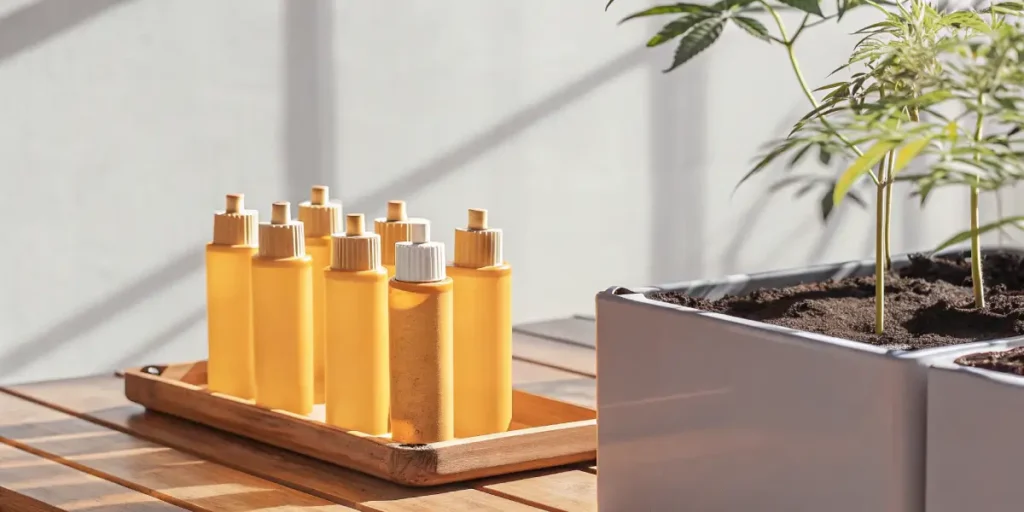Growing cannabis can be an exciting journey, especially for beginners looking to cultivate their own plants. One of the key areas to focus on is choosing the best nutrients for your cannabis plants. It’s important to understand that cannabis has specific nutritional needs at different stages of growth. This means a successful grow comes from using the right beginner cannabis nutrients.
When starting out, it can be overwhelming to figure out which nutrients are essential. A beginner-friendly cannabis nutrient guide can simplify this process. By following this guide and using a simple cannabis nutrient plan for beginners, you can ensure your plants get the necessary nutrients without overcomplicating things.
Cannabis requires a mix of primary nutrients, secondary nutrients, and micronutrients. Beginners often focus on the primary nutrients: nitrogen (N), phosphorus (P), and potassium (K). These are often referred to as NPK and are crucial for cannabis growth. The right balance of these nutrients will help you achieve healthy, vibrant plants.
The Basics of Cannabis Nutrients
Before diving into the specifics, it’s crucial to grasp the basic nutrient requirements of cannabis plants. During the vegetative stage, cannabis plants need more nitrogen. This nutrient supports the development of lush, green foliage. As the plant transitions to the flowering stage, it demands more phosphorus to support bud development and potassium for overall plant health.
Secondary nutrients like calcium, magnesium, and sulfur are also essential. They support various physiological functions and help prevent deficiencies. Micronutrients, although required in smaller quantities, play a significant role in cannabis growth. These include iron, manganese, zinc, copper, and molybdenum.
Knowing the function of each nutrient can help you make informed decisions when selecting the best nutrients for beginner cannabis growers. A solid grasp of these fundamentals can prevent common mistakes and set the foundation for a successful cultivation experience. With a simple cannabis nutrient plan for beginners, you can avoid the confusion that often comes with nutrient management.
It’s vital to remember that each stage of growth presents unique nutritional needs. By adhering to a cannabis nutrient schedule for beginners, you can systematically address these needs. This structured approach ensures that your plants receive the appropriate nutrients, promoting robust growth and minimizing the risk of deficiencies.
Choosing the Best Nutrients for Beginner Cannabis Growers
One of the easiest ways to ensure your plants get the right nutrients is to use pre-formulated nutrient solutions. These solutions are specifically designed to meet the needs of cannabis plants at various stages. For beginners, it’s best to start with a simple cannabis nutrient plan that includes both macro and micronutrients.
Some growers prefer organic nutrients, while others go for synthetic options. Organic nutrients are derived from natural sources and can improve soil health over time. Synthetic nutrients, on the other hand, offer precise control over nutrient levels and are often easier for beginners to manage.
When selecting the best nutrients for beginner cannabis growers, consider ease of use and availability. Many nutrient brands offer starter kits specifically designed for novice growers, which simplify the process. These kits often come with clear instructions, ensuring you have the guidance needed to nourish your plants effectively.
It’s also wise to read reviews and seek recommendations from other growers who have experience with beginner cannabis nutrients. Learning from others’ experiences can help you avoid pitfalls and choose products that will work best for your specific growing conditions. This collaborative approach can significantly enhance your growing journey.
How to Feed Cannabis Plants for Beginners
Feeding cannabis plants can be a straightforward process if you follow a structured cannabis nutrient schedule for beginners. Start by using half the recommended dose of nutrients to avoid nutrient burn, which can damage your plants. Gradually increase the dosage as your plants adapt.
Watering plays a crucial role in nutrient uptake. Ensure your plants receive the right amount of water without overwatering. Overwatering can lead to nutrient lockout, where roots are unable to absorb nutrients effectively. It’s a common mistake among beginners but can be avoided with careful attention.
By adhering to a beginner-friendly cannabis nutrient guide, you can create a feeding routine that promotes healthy growth. This guide typically provides detailed instructions on how to feed cannabis plants for beginners, offering insights into nutrient ratios and timing. Following such a guide can simplify the feeding process and boost your confidence as a grower.
Regular monitoring and adjustment of your feeding routine are critical. As you observe your plants, you may need to tweak your approach to better suit their needs. This flexibility is key to responding to any changes in growth patterns, ensuring that your simple cannabis nutrient plan for beginners remains effective and supportive of plant health.
Cannabis Nutrient Plan for Beginners
- Start with a simple nutrient solution designed for cannabis.
- Use half-strength nutrients initially to avoid nutrient burn.
- Gradually increase nutrient concentration as plants mature.
- Monitor pH levels to ensure efficient nutrient uptake.
- Adjust feeding schedule based on plant growth stages.
Creating a cannabis nutrient plan for beginners involves understanding the growth stages of your plants. During the vegetative stage, focus on providing ample nitrogen to support growth. As your plants enter the flowering stage, shift to higher phosphorus and potassium levels to encourage bud formation.
Regular observation is key. Look for signs of nutrient deficiency or excess. Common symptoms include yellowing leaves, stunted growth, or burnt leaf tips. Adjust your nutrient plan accordingly to address these issues. Every strain has its nuances, so learning through observation is invaluable.
Incorporating feedback from your plants can enhance the effectiveness of your cannabis nutrient schedule for beginners. This schedule should remain adaptable to your plant’s needs, allowing you to make timely adjustments that optimize growth. By being attentive and responsive, you can ensure your plants reach their full potential.
Documenting your progress and any adjustments you make can serve as a valuable resource for future grows. This record-keeping helps you refine your simple cannabis nutrient plan for beginners, identifying successful strategies and areas needing improvement. Such insights can lead to even more rewarding cultivation experiences down the line.

FAQs
What are the best nutrients for beginner cannabis growers?
For beginner cannabis growers, it’s important to start with a balanced nutrient solution that provides all essential macro and micronutrients. Pre-formulated nutrient solutions are a great choice, as they simplify the feeding process. Look for products specifically designed for cannabis to ensure your plants receive the right nutrients at each growth stage.
Strains like Blue Dream, Sour Diesel, and Northern Lights from Global Green Genetics are excellent choices for beginners. They are known for their resilience and can thrive with a basic nutrient regimen. Always follow the manufacturer’s instructions and adjust as needed based on your plants’ response.
When seeking the best nutrients for beginner cannabis growers, consider the specific needs of your chosen strain. Some strains may respond better to certain nutrient formulations, so understanding these preferences can enhance your growing results. Tailoring your approach to your strain’s requirements can significantly impact your cultivation success.
Engaging with online forums and communities can provide additional insights and recommendations. Fellow growers often share their experiences with different nutrient products, offering valuable advice for selecting the most effective options. This community support can be a powerful resource for navigating the complexities of beginner cannabis nutrients.
How often should I feed my cannabis plants?
The frequency of feeding depends on the growing medium and environmental conditions. Typically, cannabis plants should be fed every other watering. This allows the roots to absorb nutrients without becoming overwhelmed. Always observe your plants and adjust the feeding schedule if necessary.
During the vegetative stage, plants may require more frequent feeding due to their rapid growth. As they transition to the flowering stage, adjust the feeding schedule to meet the changing nutrient demands. Strains like Northern Lights are known for their robust growth, so monitoring their specific needs is crucial.
Understanding how to feed cannabis plants for beginners involves recognizing the signs that your plants provide. Changes in leaf color or growth speed can indicate a need to adjust your feeding frequency. By paying close attention to these cues, you can fine-tune your approach for optimal plant health.
Documenting your feeding schedule and plant responses can help you identify effective patterns. Over time, this record can guide you in developing a more precise cannabis nutrient schedule for beginners. Such a tailored schedule enhances your ability to meet your plants’ nutritional needs effectively.
Can I use organic nutrients for cannabis plants?
Yes, organic nutrients are a popular choice among cannabis growers. They are derived from natural sources and can improve soil health over time. Organic nutrients often contain beneficial microbes that enhance nutrient uptake and promote healthy root development.
When using organic nutrients, it’s important to remember that they may take longer to show results compared to synthetic options. However, many growers find the benefits of improved soil health and flavor to be well worth the wait. Be patient and adjust your schedule as needed for optimal results.
Exploring organic nutrients can be particularly rewarding for those interested in sustainable growing practices. These nutrients often align with eco-friendly principles, contributing to a healthier environment. For many, the slower but steady results of organic nutrients align with their broader growing goals.
By incorporating organic options into your simple cannabis nutrient plan for beginners, you can explore the full range of benefits they offer. This approach not only supports plant health but also enriches the soil, creating a more resilient growing environment for future cultivation efforts.
What is nutrient lockout and how can I prevent it?
Nutrient lockout occurs when cannabis plants are unable to absorb nutrients due to imbalanced pH levels or excessive nutrient concentration. This can lead to deficiencies and stunt plant growth. To prevent nutrient lockout, regularly monitor and adjust the pH of your water and nutrient solution.
Overfeeding is a common cause of nutrient lockout, so start with a diluted nutrient solution and gradually increase it. Ensure proper drainage and avoid overwatering, as excess water can exacerbate nutrient lockout. Strains like Sour Diesel require careful attention to avoid these common pitfalls.
Preventing nutrient lockout is integral to following a successful cannabis nutrient schedule for beginners. By maintaining appropriate pH levels and avoiding overfeeding, you can protect your plants from nutrient-related issues. This proactive approach helps ensure your plants remain healthy and productive.
Regularly testing your soil and nutrient solutions can provide insights into potential imbalances before they become problematic. This preventative measure allows you to make informed adjustments, supporting your plants’ ability to absorb the beginner cannabis nutrients they need to thrive.
What should I do if I notice nutrient deficiencies in my plants?
If you notice signs of nutrient deficiencies, such as yellowing leaves or stunted growth, take immediate action. First, identify the specific deficiency by examining the symptoms. Adjust your nutrient plan to address the deficiency by adding the necessary nutrients.
It’s also important to check the pH levels, as imbalanced pH can mimic deficiency symptoms. If imbalances are found, adjust accordingly. By closely monitoring your plants and making timely adjustments, you can ensure a healthy and productive grow. Strains like Blue Dream may have specific nutrient needs, so tailor your approach accordingly.
Addressing nutrient deficiencies promptly is crucial to maintaining plant health. Swift identification and correction can prevent further damage and promote recovery. Engaging with a beginner-friendly cannabis nutrient guide can provide strategies for troubleshooting and resolving these issues effectively.
Learning to interpret the signals your plants provide can greatly enhance your growing skills. By understanding the nuances of different deficiencies, you can refine your simple cannabis nutrient plan for beginners, ensuring that your plants receive the balanced nutrition they require for optimal growth.





